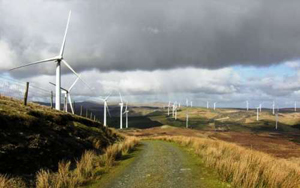The UK's far-reaching energy plan: not perfect, but the only realistic road to decarbonisation
on
The UK's far-reaching energy plan: not perfect, but the only realistic road to decarbonisation
Some of the key provisions of the UK government's draft energy bill, released in May 2012, have come under sharp criticism. This applies in particular to the new scheme aimed at supporting investment in low-carbon generation (nuclear power and renewable energy), which will give producers government-guaranteed prices for their output. Yet, according to independent energy analyst Jonathan Lane, the government has little choice but to go ahead with its plan if it is to deliver on its decarbonisation agenda. The main problem will be in getting the details right once the bill is passed in the second half of 2012.
 |
| Renewable energy development in Croydon, England (c) Peter Macdiarmid/Getty Images |
The most controversial part of the UK government's latest draft energy bill, released in May 2012 and expected to be passed into law in the second half of 2012, are undoubtedly the measures known as the Electricity Market Reform (EMR). There are four major parts to the EMR:
1. A contracts-for-difference (CfD) scheme aimed at supporting investment in low carbon generation;
2. A capacity market where generators will be paid for having capacity available as well as generating electricity;
3. A carbon price floor ; and
4. An emissions performance standard (EPS) which will cap the carbon emissions of any new electric generation plant to be built in the UK
The main policy goals of the EMR are to help the UK reach its 80% decarbonisation target by 2050 ambitions and to ensure that 15% of its electricity is generated from renewable sources by 2020. To reach the 80% target the government estimates that it will need to completely decarbonise electricity generation by the 2030s, which, according to the government, means that the UK will have to rely on a mix of renewable and nuclear generation.
This idea of a mix of renewables and nuclear has broad political support. In addition, nobody is in any doubt that the current market structure will not bring forward sufficient low carbon generation, given the cost differential between low carbon generation and fossil fuelled generation. To solve this problem, the government has introduced the contracts-for-difference (CfD) scheme.
Strike price
The CfD proposal is by far the most controversial of the four parts of the EMR. It seems as though everyone has an opinion on it, the majority of them negative. Large energy companies such as SSE have described it as a "train wreck", smaller companies say that they will be forced out of business. Even EDF, the main company expected to benefit from the reforms, has put the development of its new nuclear plant at Hinckley Point on hold.
So where did it all go so wrong for the Department of Energy & Climate Change (DECC)? And is the criticism justified? Firstly, it's no secret that the reforms are aimed primarily at supporting new nuclear new build in a world where nuclear is increasingly seen as expensive and dangerous. Although DECC has stated that its planned new subsidy scheme will apply to all low carbon generation technologies, it is clear that it addresses the needs of the nuclear industry best.
CfD's are designed to eliminate price volatility risk for generators that have large upfront capital costs by
| Large energy companies have described the Electricity Market Reform as a "train wreck", smaller companies say that they will be forced out of business |
The first criticism of the CfD's is that they are a hidden subsidy for nuclear, something the government has repeatedly stated it will not provide. If this is true, the nuclear industry isn't exactly jumping with joy at the proposal. Whilst the withdrawal of Eon and RWE from the UK's nuclear industry was largely expected given their financial problems and the closure of Germany's nuclear industry, the reactions from GDF Suez and EDF are more troubling for the government. Both have put new construction plans on hold, with GDF Suez saying it needs more support and EDF delaying the award of a civil engineering contract for Hinckley Point. Whilst both moves could be seen as commercial brinkmanship, it is also true that the government's plan is still suffering from a lack of detail.
Too complex
It is in this detail where the problems truly lie. Firstly how will the strike price be set? All that we know is that in the short term it will be set "administratively", on a cost-reflective basis and that the government hopes that competition can set the price in the future. With the prospect of competition in nuclear new build looking completely unrealistic at present or even in ten years' time, you'd have to pity the poor civil servants negotiating a cost-reflective price with EDF or anybody else.
We also have no clue as yet how long the contracts would last and what scope there could be for renegotiation. The government states that in principle it favours the grandfathering (the principle that prices in contracts will not be changed retrospectively) of CfD's to support investor confidence but this
| With the prospect of competition in nuclear new build looking completely unrealistic at present, you'd have to pity the poor civil servants negotiating a cost-reflective price with EDF |
Other arguments have been voiced against CfD's, but they seem less convincing. Energy producer SSE claims that the CfD's will transfer the risk of price volatility from generators - who are well equipped to deal with it - to consumers, who are not. That seems doubtful, given the fact that it will be suppliers, albeit through a currently unformulated method, that will recover the costs of CfD's from consumers. They should be more than adequately capable of managing volatility.
Smaller renewable developers claim that the CfD's will be too complex and risky for them and will favour larger companies. Whilst this is possible, it ignores the fact that Ofgem, the British energy regulator, is simultaneously, proposing that the "Big Six" energy suppliers be forced to auction 20% of their capacity. This measure is aimed at improving the liquidity and depth in the traded market and to improve the ability of renewable generation projects to attract financing with longer-term power purchase agreements. No doubt, smaller developers would also like the upper capacity limit for the small scale feed-in tariff mechanism to be raised and this could be a neat resolution for DECC and Ofgem which are both keen to encourage smaller players.
Market mechanism
 |
| 'The government should increase the upper capacity limit for its feed-in tariff scheme to encourage smaller onshore wind developers which are too small to be interested in CfDs' (c) reNews Europe |
The major criticism of the proposal to introduce a carbon floor price is that this undermines the market mechanism of the EU's Emission Trading Scheme (ETS). Whilst this is true, the EU-ETS has completely failed to support an adequate carbon price to encourage the decarbonisation of electricity generation. Indeed the carbon price is currently so low that Germany has been producing a record volume of renewable electricity whilst its carbon emissions from electricity generation have increased due to the low cost of coal-fired generation at present. The ability of the EU to effectively ration carbon amongst the member states has been very weak, leaving the UK government little option to take matters into its own hands if it is to reach its 80% decarbonisation target by 2050. Whilst in theory the EU-ETS is the best mechanism for pricing carbon, it does not seem unreasonable to conclude, as the UK government has done, that it needs some extra help at present.
Greenest government in history
With the UK operating a highly competitive energy market it is no surprise to see the proposed CfD being met with intense criticism from those companies without the desire or resources to develop new nuclear generation. Admittedly, the fact that the proposals support the nuclear industry the best is a desired outcome - if an unspoken one - on the part of the government, given that this is the toughest nut it has to crack.
What needs to happen as soon as possible after the passage of primary legislation is for more practical detail to be worked out for prices, contract lengths and contract mechanisms for both offshore wind and nuclear generation. Such concrete details will give investors, developers and equipment manufacturers the comfort needed to go forward with their plans. This will not be easy - on one side the government needs to attract this investment to meet its plans to be the "greenest government in history", on the other it cannot afford to give huge profits to industry at the expense of consumers.
Nevertheless, the government has little option but to press ahead if it is to deliver its decarbonisation agenda. The energy bill has broad political support across the UK's three main political parties and should pass into law in the second half of 2012 in more-or-less its current form. Then the hard work of
| The government has little option but to press ahead if it is to deliver its decarbonisation agenda |
The government should implement contracts with price-reopeners to protect itself from paying too much, whilst setting a price that shares some of the construction risk with industry. It should also increase the upper capacity limit for its feed-in tariff scheme to encourage smaller onshore wind developers which are too small to be interested in CfDs. These measures will give it the best possible chance to meet its decarbonisation goals whilst giving consumers some protection against rising electricity bills. In short, the government needs to get its regulatory and price risk right. The ability to reconsider and refine the recipe will be crucial to long term success.
|
About the author Jonathan Lane is an independent energy analyst and consultant with 20 years of experience analysing the UK and European energy markets. His main areas of expertise are market modelling, policy analysis, market liberalisation, energy market design and smart grids technologies. You can contact Jonathan on lanejon5@gmail.com. |


Discussion (0 comments)